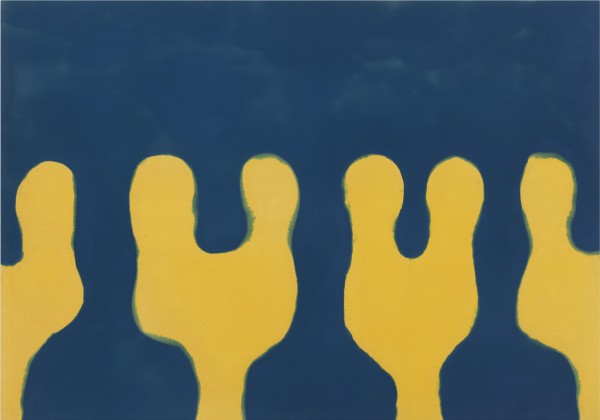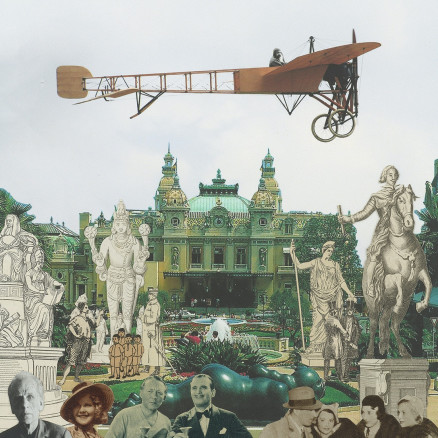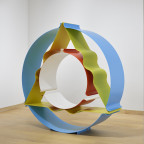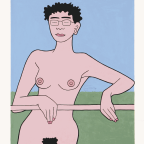Biography
Born in Des Moines, Iowa in 1910, Paul Feeley studied painting at Menlo College, Menlo Park, California and the Art Students League. After completing his training, Feeley began teaching, first at Cooper Union (1935–1939) and later at Bennington College. The artist remained at Bennington for 27 years (1939–1966) and founded its celebrated art department. Committed to the art of his peers, Feeley exposed his students – among them, Helen Frankenthaler – to many of the most significant artists of his time. In addition, while at Bennington, he organised the first retrospective exhibitions of Hans Hoffmann, Jackson Pollock and David Smith.
Feeley’s early work was both intensely formal and technically innovative. Although classically derived, his paintings from this period are looser, more gestural and less emblematic than his better-known work from the mid-1960s. In later paintings, the forms gradually solidify and become more evocative of real life experiences. Simple shapes, which at the same time seem both poised and exuberant, are Feeley’s hallmark. Between 1962 and 1966 he created a series of paintings of jacks, which was uniquely suited to his ongoing interest in seriality and repetition, one shared by many Minimal and Pop artists but comparatively few of his colour field ‘peers.’
Throughout the 1950s, 1960s, and 1970s, Feeley had solo exhibitions at many prominent institutions, including: Tibor de Nagy Gallery (1954, 1955, 1958, New York), Betty Parsons Gallery (1960, 1962, 1963, 1964, 1965, 1966, 1970, 1971, 1975, New York), and Kasmin Gallery (1964, London). During this period, his work was also featured in important museum exhibitions, such as Post Painterly Abstraction (1964, Los Angeles County Museum of Art), The Shaped Canvas (1964, Solomon R. Guggenheim Museum), The Responsive Eye (1965, Museum of Modern Art), and Systemic Painting (1966, Solomon R. Guggenheim Museum), among others. In 1968, the Solomon R. Guggenheim Museum mounted a memorial retrospective exhibition of his work. A full-career retrospective of Feeley’s work recently took place at the Albright-Knox Art Gallery (2014–2015, Buffalo) and the Columbus Museum of Art (2015–2016), accompanied by a fully illustrated catalogue.
Feeley’s work is featured in the collections of major museums around the United States of America, including: the Albright-Knox Art Gallery, Buffalo; Baltimore Museum of Art; Broad Art Museum, Michigan State University; Carnegie Museum of Art, Pittsburgh; the Columbus Museum of Art; the Detroit Institute of Arts; the Fogg Museum, Harvard University; the High Museum of Art, Atlanta; the Hirshhorn Museum and Sculpture Garden, Smithsonian Institution, Washington, D.C.; Kemper Art Museum, Washington University, St. Louis; the McNay Art Museum, San Antonio; the Metropolitan Museum of Art; the Museo de Arte Contemporáneo, Buenos Aires; the Museum of Fine Arts, Boston; the Museum of Modern Art; the Neuberger Museum of Art, State University of New York, Purchase; the Phoenix Art Museum; the Solomon R. Guggenheim Museum; the Wadsworth Atheneum, Hartford, Connecticut; and the Whitney Museum of American Art.
Read moreWorks
-
 Paul Feeley, Delta, 1965
oil-based enamel on wood
36 x 36 x 36 in,
91.4 x 91.4 x 91.4 cm
Paul Feeley, Delta, 1965
oil-based enamel on wood
36 x 36 x 36 in,
91.4 x 91.4 x 91.4 cm
-
 Paul Feeley, El 5, 1965
oil-based enamel on wood
8 x 8 x 8 in / 20.3 x 20.3 x 20.3 cm
%3Cdiv%20class%3D%22artist%22%3E%3Cspan%20class%3D%22artist%22%3E%3Cstrong%3EPaul%20Feeley%3C/strong%3E%3C/span%3E%3C/div%3E%0D%3Cdiv%20class%3D%22title%22%3E%3Cem%3EEl%205%3C/em%3E%2C%201965%3C/div%3E%0D%3Cdiv%20class%3D%22medium%22%3Eoil-based%20enamel%20on%20wood%3C/div%3E%0D%3Cdiv%20class%3D%22dimensions%22%3E8%20x%208%20x%208%20in%20/%2020.3%20x%2020.3%20x%2020.3%20cm%3C/div%3E
Paul Feeley, El 5, 1965
oil-based enamel on wood
8 x 8 x 8 in / 20.3 x 20.3 x 20.3 cm
%3Cdiv%20class%3D%22artist%22%3E%3Cspan%20class%3D%22artist%22%3E%3Cstrong%3EPaul%20Feeley%3C/strong%3E%3C/span%3E%3C/div%3E%0D%3Cdiv%20class%3D%22title%22%3E%3Cem%3EEl%205%3C/em%3E%2C%201965%3C/div%3E%0D%3Cdiv%20class%3D%22medium%22%3Eoil-based%20enamel%20on%20wood%3C/div%3E%0D%3Cdiv%20class%3D%22dimensions%22%3E8%20x%208%20x%208%20in%20/%2020.3%20x%2020.3%20x%2020.3%20cm%3C/div%3E -
 Paul Feeley, Alnitah, 1964
oil-based enamel on canvas
59 1/2 x 59 1/2 in,
151.1 x 151.1 cm
Paul Feeley, Alnitah, 1964
oil-based enamel on canvas
59 1/2 x 59 1/2 in,
151.1 x 151.1 cm
-
 Paul Feeley, Untitled (February), 1963
oil-based enamel on canvas
20 x 16 in,
50.8 x 40.6 cm
Paul Feeley, Untitled (February), 1963
oil-based enamel on canvas
20 x 16 in,
50.8 x 40.6 cm
-
 Paul Feeley, Germanicus, 1960
oil-based enamel on canvas
66 5/8 x 94 5/8 in
169 x 240.4 cm
Paul Feeley, Germanicus, 1960
oil-based enamel on canvas
66 5/8 x 94 5/8 in
169 x 240.4 cm
-
 Paul Feeley, Installation image, 'Imperfections by Chance: Paul Feeley Retrospective, 1954-1966', Albright-Knox
Image courtesy the Estate of Paul Feeley and Garth Greenan Gallery, New York
Paul Feeley, Installation image, 'Imperfections by Chance: Paul Feeley Retrospective, 1954-1966', Albright-Knox
Image courtesy the Estate of Paul Feeley and Garth Greenan Gallery, New York
-
 Paul Feeley, Installation image, 'Imperfections by Chance: Paul Feeley Retrospective, 1954-1966', Albright-Knox
Courtesy the Estate of Paul Feeley and Garth Greenan Gallery, New York
Paul Feeley, Installation image, 'Imperfections by Chance: Paul Feeley Retrospective, 1954-1966', Albright-Knox
Courtesy the Estate of Paul Feeley and Garth Greenan Gallery, New York
Book your visit
Waddington Custot has reopened its doors with a new exhibition of works by American artist Paul Feeley. The show is free to visit, but bookings are advised and can be made here.
'Paul Feeley: Space Stands Still' is the first UK exhibition dedicated to the artist in over 50 years. Many works, including oil on canvas paintings and three-dimensional sculptures in wood, are shown in the UK for the first time.
The works are characterised by Feeley’s distinctive approach to symmetry and pattern through curving shapes in vibrant colours. The central forms and repeated motifs, often in symmetrical clusters, are reminiscent of vertebrae and teeth, molecular structures or jacks.
Read moreCreative Family Event
Waddington Custot is hosting a creative family event around the current exhibition Paul Feeley: Space Stands Still, the first UK exhibition of the late American artist in half a century.
It’s a kids take over! A host of Feeley activities will inspire our littlest visitors to imagine their own abstract compositions, play with shape and colour, and delve deeper into what shapes and patterns mean to us. Children will be able to build their own activity book and create a mini Paul Feeley sculpture to take home, using the same flat-pack designs as the artist.
This creative family event will run Friday 4 May, 2-5pm with 45 minute slots which can be pre-booked here.
Read moreLatest




























